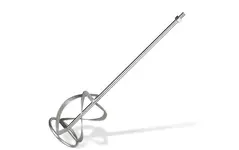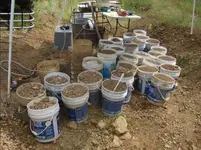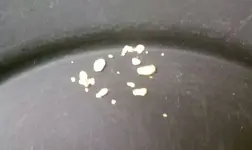H&F909ORO
Sr. Member
- Joined
- Dec 26, 2013
- Messages
- 410
- Reaction score
- 243
- Golden Thread
- 0
- Location
- California East Bay
- Primary Interest:
- Other
Hi All,
So, today I was up at mineral bar doing some crevicing and noticed something very interesting. Past the bridges going down stream on the left hand side of the river there is a lot of bed rock. The first few hundred feet has this dirt that has small pebbles and is a desert dirt color. I have found some tiny prices in that before, but I decided to move further down. I was seeing a whole different type of dirt. It was a grayish color almost like sand. There was sand in a lot of places as well. I started to dig this one crevice out and it was a big whole that went sliding into the bedrock and it contained brown clay. I have seen this type before and have noticed gold does not like to go with it. I took a lot of this clay like dirt out and panned it to find 4 nice tiny flakes. Since it had good results I went for more. I only scraped the top when I got the flakes. Now I was getting pure Clayish material out, only to find the next two panfulls to contain nothing. Why is that? I though gold traveled with this kind of dirt. Anyway I found a spot that had a rusty color to it. It turned out to be my best crevice. It contained tons of small fine gold flakes in it and I worked it for about an hour. It have good results. So, in conclusion on the couple hundred yard stretch of bedrock I found light brown clay, gray dirt, sand, brown dirt, and a rusty type dirt. They were all in sections. Why is the dirt different in a short distance? I don't get it. Any suggestions on what this might mean? I wish I got pictures, but forgot to take some.
So, today I was up at mineral bar doing some crevicing and noticed something very interesting. Past the bridges going down stream on the left hand side of the river there is a lot of bed rock. The first few hundred feet has this dirt that has small pebbles and is a desert dirt color. I have found some tiny prices in that before, but I decided to move further down. I was seeing a whole different type of dirt. It was a grayish color almost like sand. There was sand in a lot of places as well. I started to dig this one crevice out and it was a big whole that went sliding into the bedrock and it contained brown clay. I have seen this type before and have noticed gold does not like to go with it. I took a lot of this clay like dirt out and panned it to find 4 nice tiny flakes. Since it had good results I went for more. I only scraped the top when I got the flakes. Now I was getting pure Clayish material out, only to find the next two panfulls to contain nothing. Why is that? I though gold traveled with this kind of dirt. Anyway I found a spot that had a rusty color to it. It turned out to be my best crevice. It contained tons of small fine gold flakes in it and I worked it for about an hour. It have good results. So, in conclusion on the couple hundred yard stretch of bedrock I found light brown clay, gray dirt, sand, brown dirt, and a rusty type dirt. They were all in sections. Why is the dirt different in a short distance? I don't get it. Any suggestions on what this might mean? I wish I got pictures, but forgot to take some.
Upvote
0





